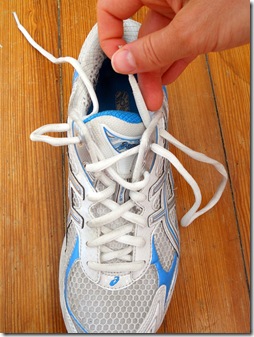For most of us, when we purchase a new pair of sneakers, we keep the laces the way they are when we tried them on. We might have a preference on how they are laced, but it’s primarily aesthetic — do you want the lace at your toes to be outside the grommets or inside?

But when it comes to running shoes, lacing is one of many aspects that becomes strategic. There are particular ways to lace your shoes for arch support, wide feet, numb toes… The list is longer than most people’s daily runs.
The most common advice for runners is to take advantage of the extra set of holes at the top of your shoes, often called bunny loop lacing, demonstrated here by Bruce Wilk, founder of Orthopedic Rehabilitation Specialists, a Physiquality network member in Miami. You lace your shoes in the traditional manner and loop your laces back through the extra eyelets as shown in the photo below. Then run the ends of your laces through the loops and tie your shoes as you normally would. Your shoes will be more anchored to your feet, and you’ll be less likely to develop blisters.

Many runners also worry about their laces coming untied – no one wants to stop several times throughout a run to retie his shoes. Be sure to double knot your laces to keep them secure. (If you’re tired of having this problem as a runner, you can always buy a shoelace buckle or lace anchor to keep those laces locked.)
If you run on a regular basis, you may want to change up your lacing techniques pending the problems you develop. The infographic below (courtesy of Run Repeat) demonstrates how to lace your shoes if you’ve been having problems with toe pain or swollen feet, as well as lacing patterns specific to your type of foot and how your shoes fit.
Above all, make sure that you have the right shoe for your feet. If your shoes don’t fit your feet correctly, you are literally starting off on the wrong foot. You should also pay attention to your gait, or your foot fall and running patterns.
If you notice chronic pain, or you have had repeated injuries from running, talk to your physical therapist about a gait analysis. Gait analysis measures body movements and angles, body mechanics and muscle function. It can be used to identify problem areas, assess efficiency and treat areas of potential breakdown, allowing you to minimize injuries and hit the ground running.
Need a physical therapist to prevent running injuries? Find a Physiquality physical therapist in your neighborhood by entering your zip code in the locator below.
Top 10 running shoe lacing techniques. RunRepeat.
Wilk, Bruce. Bunny loop lacing for running shoes. Physical Therapy Miami on YouTube.com, August 29, 2016.
Preparing for your first race. Physiquality, September 1, 2015.
George, Alexander. This is the right way to tie your running shoes. Popular Mechanics, May 12, 2015.
Can I use my running shoes’ seventh eyelets to fix heel slipping? Stack Exchange, May 2, 2013.
Lacing infographic ©RunRepeat.
